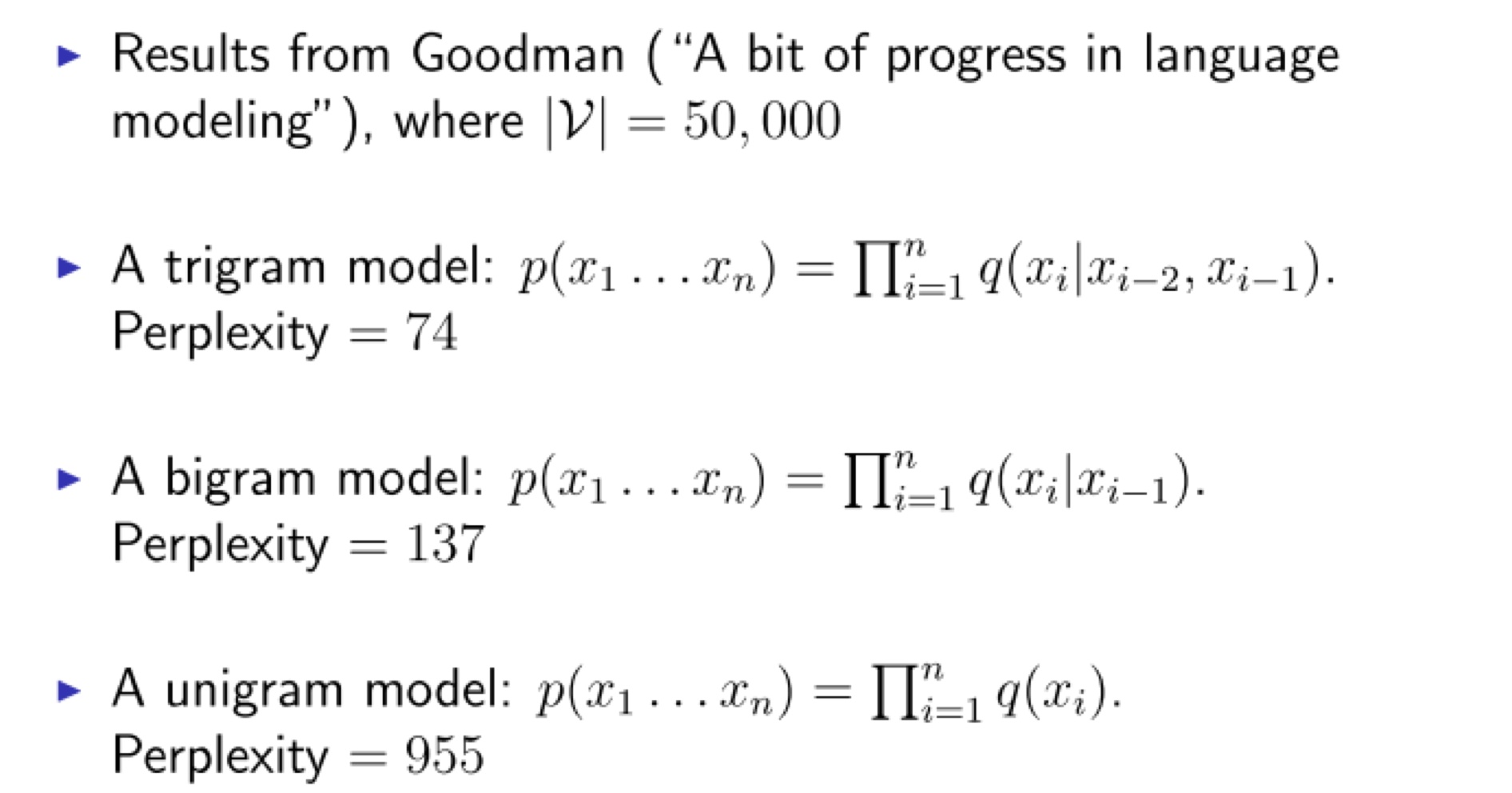欢迎关注知乎: 世界是我改变的
一. 原理介绍
在研究生实习时候就做过语言模型的任务,当时让求PPL值,当时只是调包,不求甚解,哈哈哈,当时也没想到现在会开发这个评价指标,那现在我来讲一下我对这个指标的了解,望各位大佬多多指教。
1. 这个困惑度是如何发展来的呢?
在得到不同的语言模型(一元语言模型、二元语言模型....)的时候,我们如何判断一个语言模型是否好还是坏,一般有两种方法:
- 一种方法将其应用到具体的问题当中,比如机器翻译、speech recognition、spelling corrector等。然后看这个语言模型在这些任务中的表现(extrinsic evaluation,or in-vivo evaluation)。但是,这种方法一方面难以操作,另一方面可能非常耗时,可能跑一个evaluation需要大量时间,费时难操作。
- 针对第一种方法的缺点,大家想是否可以根据与语言模型自身的一些特性,来设计一种简单易行,而又行之有效的评测指标。于是,人们就发明了perplexity这个指标。
简单说一下语言模型:语言模型(Language Model,LM),给出一句话的前k个词,希望它可以预测第k+1个词是什么,即给出一个第k+1个词可能出现的概率的分布p(xk+1|x1,x2,...,xk)。
2. 困惑度的概念
困惑度的计算是基于单词的,在自然语言处理中,困惑度是用来衡量语言概率模型优劣的一个方法。一个语言概率模型可以看成是在整过句子或者文段上的概率分布。例如每个分词位置上有一个概率分布,这个概率分布表示了每个词在这个位置上出现的概率;或者每个句子位置上有一个概率分布,这个概率分布表示了所有可能句子在这个位置上出现的概率。
困惑度(perplexity)的基本思想是:给测试集的句子赋予较高概率值的语言模型较好,当语言模型训练完之后,测试集中的句子都是正常的句子,那么训练好的模型就是在测试集上的概率越高越好,公式如下:
结论:困惑度越小,句子概率越大,语言模型越好。
下面是一些 ngram 模型经 训练文本后在测试集上的困惑度值:
可以看到,之前我们学习的 trigram 模型经训练后,困惑度由955跌减至74,这是十分可观的结果。在Brown corpus (1 million words of American English of varying topics and genres) 上报告的最低的困惑度就是使用一个trigram model(三元语法模型)。在一个特定领域的语料中,常常可以得到更低的困惑度。
二. 使用场景
我们在想衡量语言模型的好坏,然后对语言模型输出的句子进行评价。场景很简单,话不多说,上代码。
三. MindSpore的Perplexity代码实现
原理就是上面说的那些,比较好理解,话不多说直接上代码。使用的是MindSpore框架实现的代码。
- MindSpore代码实现
"""Perplexity"""
import math
import numpy as np
from mindspore._checkparam import Validator as validator
from .metric import Metric
class Perplexity(Metric):
def __init__(self, ignore_label=None):
super(Perplexity, self).__init__()
if ignore_label is None:
self.ignore_label = ignore_label
else:
self.ignore_label = validator.check_value_type("ignore_label", ignore_label, [int])
self.clear()
def clear(self):
"""清除历史数据"""
self._sum_metric = 0.0
self._num_inst = 0
def update(self, *inputs):
# 输入数量的校验
if len(inputs) != 2:
raise ValueError('Perplexity needs 2 inputs (preds, labels), but got {}.'.format(len(inputs)))
# 将输入统一转化为numpy,变为list
preds = [self._convert_data(inputs[0])]
labels = [self._convert_data(inputs[1])]
if len(preds) != len(labels):
raise RuntimeError('preds and labels should have the same length, but the length of preds is{}, '
'the length of labels is {}.'.format(len(preds), len(labels)))
loss = 0.
num = 0
# 遍历句子中的每一个单词,再进行维度的变换
for label, pred in zip(labels, preds):
if label.size != pred.size / pred.shape[-1]:
raise RuntimeError("shape mismatch: label shape should be equal to pred shape, but got label shape "
"is {}, pred shape is {}.".format(label.shape, pred.shape))
# 将label进行重塑
label = label.reshape((label.size,))
# 将label_expand转为int类型
label_expand = label.astype(int)
# label_expand扩展一维
label_expand = np.expand_dims(label_expand, axis=1)
first_indices = np.arange(label_expand.shape[0])[:, None]
pred = np.squeeze(pred[first_indices, label_expand])
if self.ignore_label is not None:
ignore = (label == self.ignore_label).astype(pred.dtype)
num -= np.sum(ignore)
pred = pred * (1 - ignore) + ignore
loss -= np.sum(np.log(np.maximum(1e-10, pred)))
num += pred.size
self._sum_metric += loss
self._num_inst += num
def eval(self):
# 分母不能为0
if self._num_inst == 0:
raise RuntimeError('Perplexity can not be calculated, because the number of samples is 0.')
return math.exp(self._sum_metric / self._num_inst)使用方法如下:
import numpy as np
from mindspore import Tensor
from mindspore.nn.metrics import Perplexity
x = Tensor(np.array([[0.2, 0.5], [0.3, 0.1], [0.9, 0.6]]))
y = Tensor(np.array([1, 0, 1]))
metric = Perplexity(ignore_label=None)
metric.clear()
metric.update(x, y)
perplexity = metric.eval()
print(perplexity)
2.231443166940565每个batch(比如两组数据)进行计算的时候如下:
import numpy as np
from mindspore import Tensor
from mindspore.nn.metrics import Perplexity
metric = Perplexity(ignore_label=None)
metric.clear()
x = Tensor(np.array([[0.2, 0.5], [0.3, 0.1], [0.9, 0.6]]))
y = Tensor(np.array([1, 0, 1]))
metric.update(x, y)
x1= Tensor(np.array([[0.2, 0.5], [0.3, 0.1], [0.9, 0.6]]))
y1 = Tensor(np.array([1, 0, 1]))
metric.update(x1, y1)
perplexity = metric.eval()
print(perplexity)- Perplexity的影响因素
- 训练数据集越大,PPL会下降得更低,1billion dataset和10万dataset训练效果是很不一样的;
- 数据中的标点会对模型的PPL产生很大影响,一个句号能让PPL波动几十,标点的预测总是不稳定;
- 预测语句中的“的,了”等词也对PPL有很大影响,可能“我借你的书”比“我借你书”的指标值小几十,但从语义上分析有没有这些停用词并不能完全代表句子生成的好坏。
所以,语言模型评估时我们可以用perplexity大致估计训练效果,作出判断和分析,但它不是完全意义上的标准,具体问题还是要具体分析。

